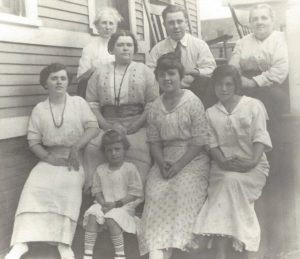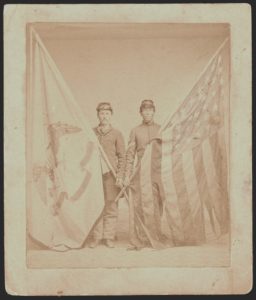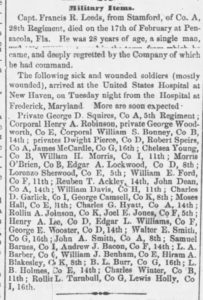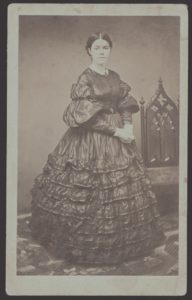Antietam Burnside Mann (c. 1915)
9 May 2024
Peter Mann married in his native Scotland in 1831, came to America in the next year or two, and had 10 children with his wife Isabella before she died in 1855. He married again, in 1857, Ann Martin Dyson, a woman who had also lost her spouse. They had a daughter Mary Agnes in 1858.
In September 1861 Peter, then a 54 year old weaver in Enfield, CT, enlisted as a Private in the 8th Connecticut Infantry. A year later he was terribly wounded in battle at Antietam, and died there on 27 September 1862. Four months later his widow Ann had their second daughter and named her Antietam Burnside Mann (1863-1943).
Antietam never married, but did not lack the company of children.
That’s her, back row at left, with her sister Mary Agnes Mann Richardson (1858-1929), back right, in about 1915. Mary Agnes’ oldest, Annie Elizabeth Richardson Breyer (b. 1877) is just in front of Antietam; Annie’s son Leland Eugene Breyer (1898) is top center. In front, left to right are 3 of Mary Agnes’ other daughters and a grand-daughter: Florence Richardson Goddu (1885), Inez Bingham (later Mansur, 1908), Inez Viola Richardson (later Allis, 1894), and Vera Antietam Richardson (later Huntley, 1895).
This lovely photograph was contributed to Antietam’s memorial by descendant Owen C Waggoner, Jr., who also identified all of those faces for us.
I’m guessing the date of the photograph from the apparent ages of the subjects, particularly Inez Bingham, who looks about 7.
Private Wheeler’s stump (1862)
8 May 2024
Specimen 2746. A cast of the left leg, after amputation, as if by the posterior flap, in the upper third. The cicatrices resemble those following a circular amputation. The integument appears tightly drawn over the bone on the anterior surface. Private J. W., “A,” 8th Connecticut: Antietam, 17th September, 1862.
“Private J. W.” was Jared Wheeler. His commanding officer at Antietam, Major John Ward thought his wound “slight” in his report of 22 September, but a week after the battle it was obviously much worse, and his leg was amputated. After more than a year in hospitals in Maryland, Connecticut, and New York, he went home with an artificial leg in November 1863.
Notes
The description of his stump from the Catalogue of the United States Army Medical Museum (1866). It’s image (and the details about his medical case) are from the The Medical and Surgical History of the War of the Rebellion (1870)
Here are Private Chester S. Rhoades (left) of Company H, 34th New York Infantry holding the state flag and Sergeant Charles B. Barton of Company C with the national colors. Both were in action at Antietam on 17 September 1862, at the head of their regiment at the front left of Major General John Sedgwick’s Division of the Union 2nd Army Corps as they crashed into the Confederates of Major General Lafayette McLaw’s Division in the West Woods that morning [map].
Colonel Suiter’s [34th New York] regiment was detached from the brigade and moved directly to the front, together with a new regiment [125th Pennsylvania] of nine months men. This support was almost fatal to the 34th, for when in the thickest of the fight, the new lines broke and ran, leaving Suiter’s command to take care of themselves. The rebels were about taking advantage of the situation by surrounding them when Sedgwick came to the rescue, and gave the order to fall back. As Sedgwick gave the order he was shot in the neck and wrist and badly wounded. This regiment barely escaped destruction.
Sometime on that fateful day Private Rhoades was killed and Sergeant Barton was shot as many as 7 times; he survived, but never fought again.
——————–
Judging by the ragged condition of the national flag, at least, that photograph was probably taken following the Peninsula Campaign of Spring/Summer 1862. It is now in the Liljenquist Family Collection of Civil War Photographs at the Library of Congress.
The quote above is from Beers’ History of Herkimer County, New York (1879).
This is a clip from the Hartford Courant of Friday 6 March 1863. Another great pile of information that I will need to go through, name by name. Eventually.
I’ve already found this useful for tracking at least two members of the 8th Connecticut Infantry wounded at Antietam on 17 September 1862 – Privates Hiram A. Blakeslee (Co. K) and Charles D Garlick (Co. I).
Galligans of Kalamazoo County, MI (c. 1862)
5 May 2024
25 year old 2nd Lieutenant George A Galligan, Company I, 17th Michigan Infantry was mortally wounded in combat at Fox’s Gap on South Mountain on the evening of 14 September 1862 and died 9 or 10 days later, probably in a field hospital in Middletown, MD.
Other than basic military service information, I’ve not found much about George after 1850, when he lived on his parent’s Michigan farm, except to find a pair of intriguing photographs accompanying his (above) in the Liljenquist Family Collection of Civil War Photographs at the Library of Congress:
The archivist has titled them, respectively, as Relative of Second Lieutenant George Galligan of Co. I, 17th Michigan Infantry Regiment, probably his wife and … probably his daughter. I’ve not been able to find their names.
If you look closely, you’ll see the carpet pattern is the same in all three photographs. The photographer is not identified for George’s portrait, but the mother and daughter’s pictures have the photographer on the back: E.A. Boughton’s Photograph Rooms, Kalamazoo, Michigan.
I’m guessing the freshly commissioned Lieutenant and his family had these taken together before he left Kalamazoo for war in August 1862.
Here’s Sergeant Lester Edwin Forrest Spofford after he lost his left arm to a wound and resulting amputation at Antietam on 17 September 1862.

You’d have thought that would have been enough of war for 18 year old Forrest, but it wasn’t. He was appointed Sergeant Major of the 8th Connecticut Infantry in January 1863 and he returned to serve with them to May of 1864, when he was wounded again. In the other arm.
After recovering from that wound he attempted to reenlist, but was turned away by a medical board and discharged at the end of his original term of enlistment on 20 September 1864.
This fine photograph is from the Buck Zaidel Collection, and was published in Military Images in Spring 2015 and featured in Longley & Zaidel’s Heroes for All Time: Connecticut Civil War Soldiers Tell Their Stories (2015).
Troup Artillery redux
30 April 2024
Fellow researcher Laura Elliott sent me a couple of lovely news clippings with further detail about the Troup Artillery on the Maryland Campaign of 1862. The first piece is from the the Athens, Georgia Southern Banner of 8 October 1862 reproducing a casualty list Captain Henry H. Carlton put in a letter to his parents:
The second is from the Banner of 1 October 1862 and has more details about some of the casualties; it was taken from a letter Corporal W A Hemphill wrote his father:
The Athens Guards, by the way, were Company K of the 3rd Georgia Infantry, also at Sharpsburg.
Thanks to Laura, I’ve had more names to look into this week.
While doing that I came upon this fine photograph of the surviving members of the Troup Artillery at their reunion in Athens on 20 July 1892 – 30 years after Sharpsburg.
That might be former Captain Carlton at the far right holding the sponge-rammer, and the man with the huge sideburns in the center of the picture beneath the battle flag is probably former Corporal Hemphill, then Mayor of Atlanta. The photograph was made by their own ex-Lieutenant C.W. Motes and was published in the Banner of 26 July 1892. This copy was posted online by the volunteers of RootsWeb.
That first piece is a little hard to read, so Laura kindly transcribed the casualties for us:
September 14 at Cramptons Gap
Killed, private John J Kinney, Serg’t John O Waddell mortally wounded, shot through the head and left on the field. Private Robert S. Thomas seriously though not dangerously wounded – shot through both legs; E. A. Lee, slightly, flesh wound, through the thigh.
September 17 at Sharpsburg
Killed – Private B R Carlton. Wounded – Lieut. C. W. Motes in side and shoulder, though not dangerous; Serg’t J. H. L. Gerdine, in thigh, dangerously; Private George B. Atkisson, breast and thigh, dangerously; W. H. P. Jones, in thigh, slight; E. C. Kinnedrew, very slight, in face; R. W. Pitman, shot through leg, not dangerous; R. W. Saye struck with ball, not serious. Privates Robert Moon, J. F. Murray and Corp’l J. M. A. Johnson badly bruised but now on duty.
Here are the soldiers of the Athens Guard mentioned by Hemphill:
George Graham, killed;
James Dorsey, shot through leg;
Dick Baxter, shot through the hand;
George Palmer, wounded;
George Daniel, wounded;
Henry Morton, wounded;
Ab Edge, well;
O’Farrell, also well.
The Troup Artillery members present at that 1892 reunion were listed in the newspaper:
Capt. H. H. Carlton, Athens, Ga.
1st Lieut. C. W. Motes, Atlanta, Ga.
H Jennings “ “
1st Lieut. A F Pope, Crawford, Ga.
J O Waddell, Atlanta, Ga.
J F Dillard, Crawford, Ga.
Howell Cobb, Corporal.
R K Pridgeon, Sergt.
A B C Dorsey, Q M Sergt.
J J Jennings, Athens, Ga.
Jesse Williams, Jefferson, Ga.
R W Pittman, Athens.
Robert Dicken, McNutt, Oconee Co.
E L Edwards, Covington.
E C Kinnebrew, Athens.
J W Hale, Winterville.
J T Hale, “
G B Atkisson “
Lee M Lyle, Middleton,
Corporal B F Culp, Athens.
H T Boneshell, Maxeys, Ga.
W J Jennings, Bethlehem.
Jas. J Jennings, Watkinsville.
W S Barrett, Ila, Madison Co. Ga.
E A Robertton, Atlanta.
D J Matthews, Bascobel.
W A Hemphill, Atlanta.
R W Saye “
T F Hudson, Athens.
F M Doster, Bascobel.
J E Bradberry, Athens.
J W Bradberry, Watkinsville.
Jesse Gann, Athens.
T S Richards “
Corporal J D Thomas, Rome.
John Lilly, Athens.
Thomas Jones, Athens.
Geo W Moon, “
Isaac Vincent, “
Obadia Vincent, “
J R Hale, ________
J W Ledbetter, [Joseph William Ledbetter, Madison, Co., GA]
O J Oliver, Atlanta.
A W Reese, Macon.
E W Porter, Athens.
J M Barry, “
T S Richards, “
Bob Flournoy “
D D Blackman, Atlanta.
G W Simmons, McNutt, Oconee Co.
J E Pittman, Athens.
2,000 faces of Antietam
24 April 2024
Antietam on the Web achieved a milestone today – we now can show you faces of 2,000 of the participants in the Battle of Antietam as they probably looked when they were there.
This is not far from 10% of the nearly 22,000 people in the AotW database and is amazing to me – I’ve been putting up pictures of them one at a time as I find them, for many years, not really keeping score.
A big thank you to all the descendants and collectors who have shared their treasured pictures with me, and to all the organizations large and small who have posted theirs online for me to find.

To mark the day, here’s one of my most recent finds and poignant faces – that of 17 year old William E Hacker of Worcester, Massachusetts. A recent graduate of a military prep school in Worcester, he was appointed 2nd Lieutenant of Company A, 3rd Maryland Infantry in March 1862, and fought with them at Antietam, where he was shot in the chest. He survived that and returned to duty in January 1863, soon after promoted to Captain, but died of typhoid fever in March 1863 at age 18.
His carte de visite (CDV) here is one of two of him in the Liljenquist Family Collection of Civil War Photographs at the Library of Congress – a massive and growing resource for people like us.
If you have a wartime picture of someone who was at the battle, or know of one online I haven’t seen yet, please let me know. I have so much more to do.
Surgeon’s Certificate, Corp Edmund Davis (1863)
21 April 2024
Here’s another excuse to show you Surgeon B. A. Vanderkieft‘s fabulous signature. In this case, on a certificate for Corporal Edmund Davis of the 35th Massachusetts Infantry, who suffered a terrible wound to his right thigh at Antietam on 17 September 1862. He recovered, in the sense that he didn’t die, but was afterward permanently disabled.
Davis returned to Massachusetts, studied the law, and began a lifelong career as a lawyer.
Sadly, nearly 35 years later, he killed himself – under threat of arrest for losing $30,000 of a client’s money in bad investments:
complete article: page 1 | page 2
Notes
His Certificate is among Corporal Davis’ Compiled Service Records at the National Archives; I got this copy from the fold3 collection.
The clipping and picture above are from a lengthy piece about Davis and his death published on the first two pages of the Boston Globe on 10 July 1897. These are online [page 1 | page 2] from newspapers.com
Death of Oliver P Forbes (1863)
21 April 2024
First Sergeant Oliver Peter Forbes was seriously wounded in the thigh at Antietam on 17 September 1862, and his surgeon thought he’d recovered by the end of the year, but he later faded and died of his wound in a field hospital at Keedysville. This notice is from the New York Times of 4 June 1863:















